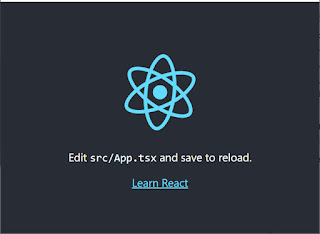Intro
This time I tried React. First, I referred Documents and Tutorial. React – A JavaScript library for building user interfacesGitHub - facebook/react: A declarative, efficient, and flexible JavaScript library for building user interfaces.
Getting started with React - Learn web development | MDN
Create a project
To create a new React project, I used "Create React App". GitHub - facebook/create-react-app: Set up a modern web app by running one command. It created these files..git
node_modules
public
L favicon.ico
L index.html
L logo192.png
L logo512.png
L manifest.json
L robots.txt
src
L App.css
L App.test.tsx
L App.tsx
L index.css
L index.test.tsx
L index.tsx
L logo.svg
L react-app-env.d.ts
L serviceWorker.ts
L setupTests.ts
.gitignore
package.json
package-lock.json
README.md
tsconfig.json
Make the page work with IE11
I could view the page by "npm start" or "npm run start".But I got white page with IE11.
npm install --save serve npm run build npx serve -s buildI could view with IE11. But the logo was stopped (It was rotated when I opened the page with Chrome or Firefox).
Rotate the logo
The logo was rotated by CSS.App.tsx
import React from 'react';
import logo from './logo.svg';
import './App.css';
function App() {
return (
<div className="App">
<header className="App-header">
<img src={logo} className="App-logo" alt="logo" />
<p>
Edit <code>src/App.tsx</code> and save to reload.
</p>
<a
className="App-link"
href="https://reactjs.org"
target="_blank"
rel="noopener noreferrer"
>
Learn React
</a>
</header>
</div>
);
}
export default App;
App.css
...
.App-logo {
height: 40vmin;
pointer-events: none;
}
@media (prefers-reduced-motion: no-preference) {
.App-logo {
animation: App-logo-spin infinite 20s linear;
}
}
...
@keyframes App-logo-spin {
from {
transform: rotate(0deg);
}
to {
transform: rotate(360deg);
}
}
App.css
...
.App-logo {
height: 40vmin;
pointer-events: none;
}
.App-logo {
animation: App-logo-spin infinite 20s linear;
}
...
@keyframes App-logo-spin {
from {
transform: rotate(0deg);
}
to {
transform: rotate(360deg);
}
}
align-items
The view what was opened with IE11 had still had a problem. "align-items" was ignored. It was because its parent element used "min-height".App.css
...
.App-header {
background-color: #282c34;
min-height: 100vh;
display: flex;
flex-direction: column;
align-items: center;
justify-content: center;
font-size: calc(10px + 2vmin);
color: white;
}
...
App.css
...
.App-header {
background-color: #282c34;
height: 100vh;
display: flex;
flex-direction: column;
align-items: center;
justify-content: center;
font-size: calc(10px + 2vmin);
color: white;
}
...
Polyfill
For using Promise, window.fetch, and etc., I could use polyfill. create-react-app/packages/react-app-polyfill at master · facebook/create-react-app · GitHub But in this sample, I didn't have to use it. And because I wanted to use IE11, I might not have to import raf/polyfill. JavaScript Environment Requirements – ReactAdd components
I followed the tutorial, I added two components. Tutorial: Intro to React – React Because "create-react-app" didn't have adding components functions, I added tsx files and css files manually.
...
src
L tic-tac-toe
L Board.css
L Board.tsx
L Square.css
L Square.tsx
L App.css
...
...
Board.tsx
import 'react-app-polyfill/ie11';
import 'react-app-polyfill/stable';
import React from "react";
import { Square } from "./Square";
import './Board.css';
export class Board extends React.Component {
private renderSquare(i: number): JSX.Element {
return (<Square value={i}
onClick={() => alert(`Click ${i}`)}>
</Square>);
}
public render(): JSX.Element {
return (
<div className="board-row">
{Array.from(Array(9).keys())
.map(i => this.renderSquare(i))}
</div>
);
}
}
Board.css
.board-row {
display: flex;
flex-direction: row;
flex-wrap: wrap;
height: auto;
width: 21vw;
}
Square.tsx
import 'react-app-polyfill/ie11';
import 'react-app-polyfill/stable';
import React from "react";
import './Square.css';
export type SquareProps = {
value: number,
onClick: () => void,
};
export class Square extends React.Component<SquareProps> {
render() {
return (<button className="square"
onClick={() => this.props.onClick()}>
{this.props.value}
</button>);
};
}
Square.css
.square{
height: 7vw;
width: 7vw;
}



コメント
コメントを投稿